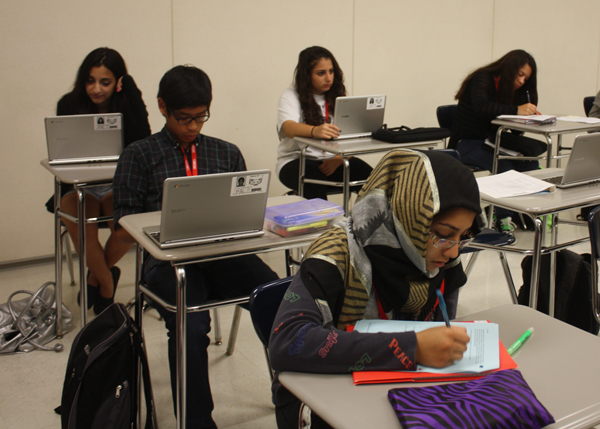
A few weeks ago, junior Breana Brill wrote a column about the most common complaints about Niles West. The very first grievance on the list was how cold the school is.
At least once a day, I hear complaints from classmates about how they’re freezing or how their classrooms are uncomfortably cold. Each classroom is equipped with an adjustable thermostat, but even if you turn it all the way up to 90 degrees, it never seems to make a difference.
“In the morning, it takes way too long to warm up,”senior Robert Marohn said. “In the mornings, I always find myself wearing jackets and parkas in APES. The school is just irregular.”
Some of you may be wondering why the thermostats don’t seem to work, or why the school is so cold, and I’m here to provide some answers.
The school has a building automation system that controls the temperatures around the entire school.
“The system doesn’t lie,” said director of building and grounds Jerzy Siemienski, who also helped in the creation of the very advanced system that includes a computerized version of the school and shows the individual temperatures in each and every classroom. (Room 2040 was at exactly 72.27 degrees.)
Even if a student or teacher does set the thermostat to 90 degrees in an attempt to warm the classroom, it won’t go above the preset gauges, which are limited to 74 degrees.
What many of you may not know is that the school does have to abide by a set of rules, which is why temperature limitations in the school range from 68-74 degrees, as per the School Board’s specifications. Niles West also prides itself on being “an energy efficient building, which us why the building needs to be at a certain range in winter and summer months,” according to Vice Principal Kendall Griffin.
“We are committed to air quality. There are national rules of air quality, and because of that, we have to supply some outside air, and we are obligated to do this,” Siemienski said.
The operations that the school undergoes to keep the air clean makes a lot of sense once it is broken down. The outside air that the school provides through the ventilation system may be unpleasant at times due to how cold it is outside, but slightly uncomfortable temperatures are a small price to pay for a clean, fresh school environment.
Some of you may still think that the school is too cold, clean air or not. Think of is this way; if you were to come to school at your desired temperature, once students start entering the school, the body heat, lights, computers, and all the combined factors would make the school about 85 degrees, which is why the cooling process is also a very important factor of the ventilation system.
“[The rooms] might be in cooling mode when the rooms are different temperatures. The cooling process is necessary. It’s similar to an airplane; no outside air is allowed in because of suction [and other factors,] leaving the air stale and recycled,” Siemienski said.
Niles West, however, provides fresh air in order to avoid air that is shared by over 3,000 people that is “stale, polluted, and full of bacteria,” according to Siemienski.
3,000 people is hard to even imagine, but just imagine the fact that Niles West is approximately 700,000 square feet, which is the size of about 233 large houses. Heating a building of that monstrous size “is always challenging,” according to Siemienski.
Despite the constant complaints and the challenges that the building provides, Griffin believes that “the building and grounds staff does a phenomenal job.”
The jobs that the building and grounds staff do are oftentimes unrecognized and overlooked. According to Griffin, “what we’re doing environmentally is something that no school in Illinois has done.”
Despite the recognition and hard work that has been put into the heating and cooling of Niles West, sophomore James McLellan still believes that “the temperature is never consistent or satisfactory.”
When asked about the complaints from students, Griffin calmly stated that “heating and cooling is a preference. There are over 3,000 people in the building; not everyone’s going to feel the same thing. Not only are we doing what’s required, but its being done in a way that has been recognized.”











Carl • Mar 20, 2013 at 2:22 PM
Im cold
Anna • Mar 15, 2013 at 11:05 PM
Honestly, with all the complaints I hear daily, it’s hard to believe that the school is at a consistent 74 degrees all day. The fact that the limit to the room temperatures is 68-74 degrees is scary. To me, that’s just too cold. I’m thinking of bringing a thermometer with me to school someday so that I can see for myself what the true temperature is in my coldest classrooms, because it’s really hard to believe sometimes that the room is 68-74 degrees. This “cooling off” process is also, in my opinion, an unpleasant experience. How is blasting cold air right on the students going to help us? And when students come to school in late August or early June, they would prefer to wear shorts and t shirts to school, not jeans and hoodies. The warmest areas of the school are the hallways during passing periods, only because of the overwhelming amounts of students at one time. Sure, maybe this process does save a lot of money and recycles the bacteria-filled air, but if the people who run this temperature regulation actually walked through this school to check these rooms, I believe they will be surprised with the inconsistent temperatures we have to live with as students every day.
John • Mar 15, 2013 at 1:11 PM
I only feel cold in certain classrooms and find it hard from a valid complaint across the entire school.